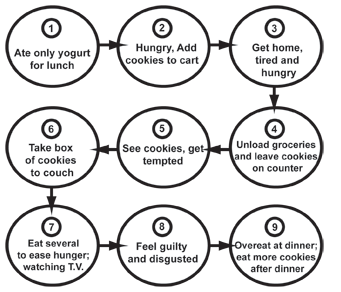Week Seven Breaking Through Barriers
BIDMC Contributor
OCTOBER 12, 2017

Step 1: Read Lesson
Making positive behavior changes takes time and effort and you will inevitably run into a few trouble spots along the way. Let's look at some strategies for problem solving when barriers arise.
Break Through Moment: The Mindful Bite
Grab a small sample of a food you have handy. Take a slow mindful bite, taking time to enjoy the flavors, texture and consistency. After your first bite write down some of your thoughts on the sample item. For example: How did it taste? What did you enjoy about it? What changed about the food from the start to the finish of the bite? Take a few more bites, while you continue with the lesson. After a moment take a minute to think about these questions: Did you notice any differences between how you ate the first bite vs. the last bite? What types of bites do you think you take usually when you eat: mindful or mindless?
Be More Mindful
The first step in problem solving is essentially being mindful of the fact
that there is a "problem". Once you learn to stay focused in the present
moment and take time to notice new things, barriers to healthy eating will
come into focus. Take time to appreciate sensual pleasures and wonders,
like the smell of a pine forest or the taste of a mango.
Here are a few more strategies:
- 4-bite rule: Do you really want that whole piece of pie? Think back to the times you have eaten the whole piece. Was the first bite as enjoyable as the last? Not usually. The first 4 bites are the most flavorful bites and from there we move to autopilot eating. Try being mindful of your first 4 bites, savoring each one, then push the plate away or share with a friend. You will still feel satisfied and yet save calories.
- Create a relaxing ambiance at meals-light a candle or set out nice placemats.
- Set your mind on portions before you snack-If put in a situation where you are in front of a plate of cookies or candy, set your mind on having a certain of number of servings that you feel comfortable with (i.e. not deprived, but not guilty either). For you this might be 2 cookies or 1 handful of party mix. Set the number in your head, enjoy the treat and walk away satisfied.
Looking Back to Move Forward
Behavior chains are a series of sometimes minor events that lead to an
undesirable outcome, like overeating. By looking back at what occurred
before you overate, you can re-create your own behavior chain and see where
you may have taken a misstep and make a plan to prevent it from happening
again.
Step 2: Watch Video
Watch Kristina Spellman's video to get tips and information to help you understand this week's principles.
Step 3: Review and Complete Activities
Activities Workbook (pdf)
Step 4: Listen to Podcast
Listen to Dr. Blackburn's podcast to keep yourself motivated.
Step 5: Take Quiz
Take the quiz to test what you've learned this week!
Step 6: Perform Weekly Tasks
- Continue to keep track of your daily intake and assess R-K-O status daily
- Continue Eat Less, Eat Well, Stress Less strategies from previous weeks
- Be more mindful at each meal
- Be aware of your behavior chains and strategize on how to break the links
